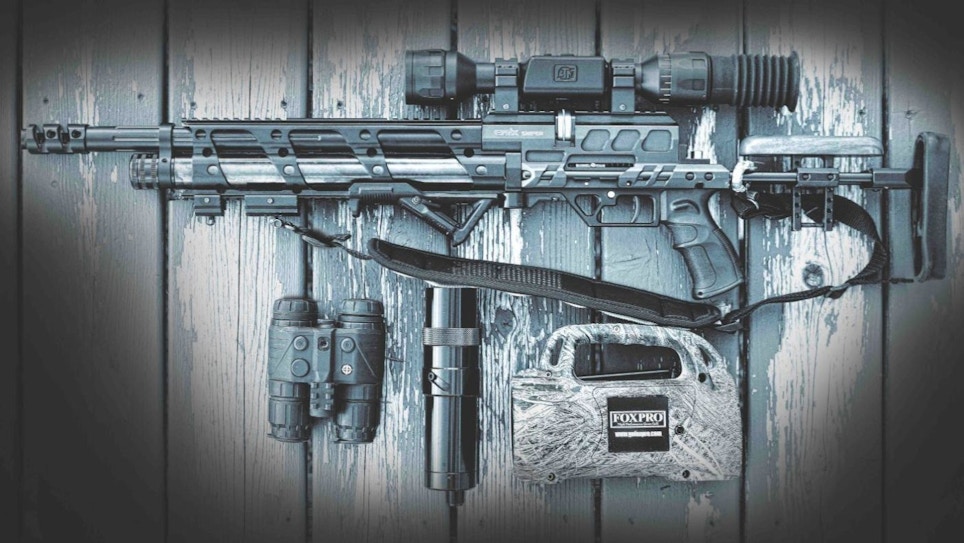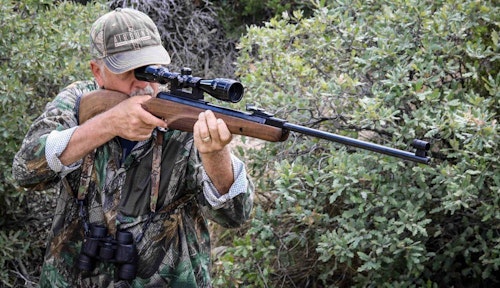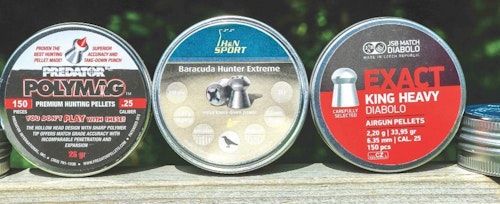Mention airguns and most of us think of the Daisy Red Ryder or the Sheridan multi-pump of our youth. But in the global market, airgun technology has developed at a rapid pace, and the American market has seen explosive growth over the last few years. Some of this growth has been driven by plinkers and competitive shooters, but the primary driver has been hunting. Regulations have evolved across much of the country, permitting airguns to be used for everything from squirrels to bears.
This article will focus on the hunting segments, discussing the types of guns and powerplants being used, the calibers currently available, appropriate projectiles and the power levels these guns can generate. Then we’ll wrap it up by taking a look at some popular guns and the current market landscape.
Most states allow some form of small game, varmint, and/or predator hunting with airguns. In recent years, several jurisdictions have permitted airguns as a legal method of take for deer and other large game. Several states allow deer hunting with airguns during the rifle season, and more are implementing or considering new laws that favor airguns every year.
The spring-piston airguns most commonly found in retail shops today are at the lower end of the pricing spectrum. These rifles are generally priced at $150 to $300 and offer a decent build quality and level of performance. This type of rifle is the cornerstone of the retail-oriented airgun market and is suitable for small-game hunting and pest control. The typical rifle in this segment is a break-barrel spring-piston action in .177 or .22 generating power in the 12 to 25-ft./lb. energy (FPE) range. These products serve their purpose and are often the only airguns a prospective customer has experience with.
In the growing ranks of dedicated airgun hunters, a different category of gun is becoming popular: higher-end rifles implementing either spring piston or precharged-pneumatic (PCP) mechanisms. These products are priced in the $300 to $2,500 range and tend to be more refined, with PCPs generally being more expensive. Perhaps it’s counterintuitive to those unfamiliar with airguns, but they are not necessarily inexpensive. There are several reasons for this, especially when discussing PCP rifles: the manufacturing tolerances are tighter, the scale of economies is smaller, and production of many of the best rifles come from countries in which a premium is placed on high-end products. However, they are far less expensive to shoot on an ongoing basis.
There are several power plants in production, including CO2, spring piston (both mechanical and gas-piston configurations), and precharged pneumatics. While CO2 is one of the best-known power plants, they are generally low power and used mostly for informal plinking guns, often in replicas of popular firearms. It’s conceivable these guns could be used for pest control, but they are rarely used for serious hunting. Unlike a firearm, airguns store energy in the gun and not the ammunition, so selection of the powerplant is very important in a hunting gun.
PCP rifles and spring-piston rifles, also known as “springers,” are preferred for hunting. Each of these have advantages and disadvantages. Springers are simple to operate, relatively inexpensive and self-contained, requiring no additional charging gear. On the downside, they are more difficult to shoot accurately, are hold-sensitive, they have a more limited power output (compared to PCPs) and they are more suited to smaller calibers such as .177 or .22.
PCP airguns have an onboard air storage system, usually an under-the-barrel reservoir or a bottle in the forestock or buttstock of the gun, that is charged from an external air supply at high pressure. The onboard air storage contains enough air to power multiple shots. Some small-bore PCPs might store enough air to generate more than 100 shots before a refill is required, down to a couple shots for some big-bores. This is dependent on the volume and pressure of air stored and the amount of air used on each shot. Some guns start to drop velocity with each shot, as the pressure in the air tank drops, and these PCPs are said to be unregulated. Regulated guns use a mechanism to reduce the pressure to a consistent and specific level so that every shot uses the same pressure, and consistency from shot to shot is significantly improved.
The disadvantages of the PCP are that they tend to be more expensive and require external fill equipment. The advantages are that PCP rifles tend to be very accurate, they can be very quiet, they can generate power up 800 fpe or more of energy, they work well with large calibers, they are mostly recoilless, and many have adjustable power. Adjustable power in an airgun serves the same purpose as handloading for a firearm, allowing the shooter to tailor the performance based on application or projectile.
If you plan to sell PCP air rifles through your business, remember that customers will require a source to fill their guns with high-pressure air. Several solutions exist. Hand pumps that look like bicycle pumps on steroids are the least expensive. SCUBA or carbon fiber (CF) air tanks can be filled at paintball or dive shops and are another option, while some customers will prefer to charge guns or tanks using a compressor. The price of compressors has dropped significantly, and if your shop builds a large enough customer base, providing a service to fill tanks can provide an additional revenue stream.
Small-game and pest-control hunters usually employ springers and PCP guns in the .22- to .25-caliber range generating 15 to 50 fpe. These guns can be quite accurate, and many PCPs are capable of half-inch accuracy at 60 yards, delivering more than enough energy to drop small game on the spot. Many guns come equipped with a shrouded barrel that reduces the sound signature to a whisper. Besides being quiet, the ballistic characteristics are such that while the gun is producing knockdown power at 60 yards, the energy is spent at 100 yards. This permits these guns to be safely used for hunting and pest control in more built-up areas.
Medium-sized game and predators are the ideal quarry for the mid-bore PCPs, shooting .30- to .35-caliber pellets in the 75 to 175 fpe range. These guns are often used for hunting coyotes inside 75 yards, where their limited carrying range and low report make them a useful tool for hunting suburban environments, which often hold large populations of game with little hunting pressure.
Big game hunting with airguns has evolved in North America over the last decade. As mentioned earlier, many states now allow deer, hogs, antelope, javelina, bear, turkey and other big game species to be taken. In my view, this sport falls somewhere between blackpowder and archery in terms of range and approach. Big game airgunning requires closing in to 60 to 100 yards and making the right shot placement — it has the challenge of archery but requires traditional marksmanship skills. Guns being used for this type of hunting are always PCP (often a legal requirement) usually in .35 to .50 caliber generating 215 to 800 fpe.
Airguns that shoot arrows are gaining a great deal of interest and are being produced by several manufacturers such as Hatsan, Umarex, Crosman, FX and Air Venturi. Some of these guns only shoot arrows, while others support interchangeable barrels that allow the gun to be used for either standard pellets or arrows.
The airguns you should stock in a retail shop depends on your customer demographics and the level of support you plan to provide. Spring-piston airguns for small-game hunting and pest control are the easiest segment to support, and products from the likes of Hatsan, Umarex, Gamo and Crosman all have extensive product offerings. If you want to up the level but still not include PCPs, higher-end springers from RWS, Weihrauch, Walther and Diana would make a good addition to the product mix.
There is a growing demand for PCP rifles as customer awareness grows, but there are few brick-and-mortar shops addressing this demand in the U.S. The primary barriers to selling PCP airguns are a lack of product knowledge by most retailers, the need to provide the accessories to charge these guns, and the inventory costs associated with often-expensive niche products. The first can be addressed with a little homework. The complexity and cost of filling gear is coming down with many products (compressors, tanks and pumps) becoming readily available, and there are many PCPs available from large-scale manufacturers that have brought the cost of PCP technology into a much more affordable range.
High-end guns and most big-bore models are currently handled primarily by online specialty vendors that might or might not have a brick-and-mortar operation as well. These hybrid shops can support a dispersed customer base while addressing the local market with a physical presence. There are potential opportunities for general hunting retailers to formulate strategies to access these niche market and connoisseur products for their customers on a local basis.
The airgun hunting market is growing, both in the scope and the number of participants. There are products currently available to address every application and every price point. As I’ve traveled around the country speaking with new airgunners as well as enthusiasts, lack of a venue where customers can look at, hold and discuss a purchase face to face is often cited as a limiting factor. I would suggest this also provides an opportunity for retailers!
Sidebar: Airguns to Consider Stocking
Here are a few airguns you might consider carrying that span the range of applications and price points. As an example of a low-cost, high-performance spring-piston rifle, one of my favorites is the Walther Parrus, a break-barrel rifle available in .177 and .22 generating velocities over 1,000 fps (in .22). The gun is smooth-shooting and easy to cock, and it offers great performance in a fairly refined package that can be sold for less than $300. It is available with either a wood or a black synthetic stock that is ergonomic and functional.
For a high-end heirloom-quality springer, I really like the Weihrauch HW 80 — it's a proven German design that is low-recoil with a smooth firing cycle. The gun generates substantial power in both .177 and .22, but what sets this gun apart for me is the fit and finish of wood and metal components. The traditional styling of the sporter stock results in a classic that will both last and hold its value. I often see these guns available around the $700 mark.
Next is the PCP segment. A couple of my favorites in this category include a traditional sporter-style rifle from Crosman called the Benjamin Marauder, which is priced at $540, and a bullpup from Hatsan called the FlashPup, priced at $420.
Stepping into the high-end enthusiast PCP space, there are several rifles from well-respected global players, such as Daystate, Brocock, AirArms and FX. My personal favorites are the FX Crown, a lightweight rifle available in .177 to .30 caliber (with an arrow barrel and slug option) starting at $1,600, and the Brocock Bantam Sniper, available in .177, .22 and .25, which can be found starting at $1,400. And the last category is the big-bore PCP. This market is driven by the U.S. consumer, regardless of where they are manufactured. Many of the rifles are produced by boutique builders as well as a few of the major airgun manufacturers. My current favorite of the uber-powerful big bores is the Hatsan Piledriver, which is priced around $1,190 and is available in both .457 and .50 caliber. Generating over 700 fpe and 800 fpe respectively, this rifle is ergonomic, accurate and consistent, and it hits like sledgehammer. This is a rifle that can take just about any big game species in North America or large-plains game in Africa.
Sidebar: Pellets and Accessories
There are several good pellets to choose from, produced by H&N, RWS, Gamo and Crosman. But the pellets I use most frequently are from JSB. The JSB Diabolo Exact series are very well made and consistent, shooting well out of most of my guns. I tend to stick to lead Diabolo pellets with a round head for hunting, though some of the new hollowpoint designs such as the innovative JSB Hades circumvent the accuracy issues often found with hollowpoints. These pellets are accurate and expand well while achieving very impressive terminal performance.
Airgun scopes, besides all the typical requirements, need to have a very good system of aimpoints and an adjustable objective correction. The reason for the aim points is that airguns have a significant trajectory that can affect the point of impact over very short increments in range. And the AO correction is predicated on shooting at closer ranges at high magnifications. Several manufacturers have a line of airgun optics, such as Hawke, Leapers/UTG, MTC and Athlon. These days, I find myself using the first focal plane MTC Cobra model. What I like about this scope is that the glass-etched crosshair and FFP reticle allow a wide range of magnifications to be used without affecting the aimpoints. I also find the glass has very good low-light capabilities, all of which make it ideal for the airgun hunter.











